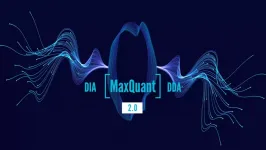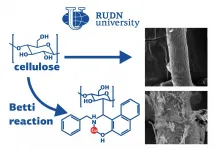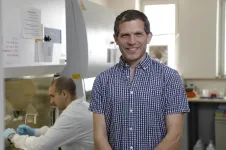(Press-News.org) Proteomics produces enormous amounts of data, which can be very complex to analyze and interpret. The free software platform MaxQuant has proven to be invaluable for data analysis of shotgun proteomics over the past decade. Now, Jürgen Cox, group leader at the Max Planck Institute of Biochemistry, and his team present the new version 2.0. It provides an improved computational workflow for data-independent acquisition (DIA) proteomics, called MaxDIA. MaxDIA includes library-based and library-free DIA proteomics and permits highly sensitive and accurate data analysis. Uniting data-dependent and data-independent acquisition into one world, MaxQuant 2.0 is a big step towards improving applications for personalized medicine.
Proteins are essential for our cells to function, yet many questions about their synthesis, abundance, functions, and defects still remain unanswered. High-throughput techniques can help improve our understanding of these molecules. For analysis by liquid chromatography followed by mass spectrometry (MS), proteins are broken down into smaller peptides, in a process referred to as "shotgun proteomics". The mass-to-charge ratio of these peptides is subsequently determined with a mass spectrometer, resulting in MS spectra. From these spectra, information about the identity of the analyzed proteins can be reconstructed. However, the enormous amount and complexity of data make data analysis and interpretation challenging.
Two ways to analyze proteins with mass spectrometry
Two main methods are used in shotgun proteomics: Data-dependent acquisition (DDA) and data-independent acquisition (DIA). In DDA, the most abundant peptides of a sample are preselected for fragmentation and measurement. This allows to reconstruct the sequences of these few preselected peptides, making analysis simpler and faster. However, this method induces a bias towards highly abundant peptides. DIA, in contrast, is more robust and sensitive. All peptides from a certain mass range are fragmented and measured at once, without preselection by abundance.
As a result, this method generates large amounts of data, and the complexity of the obtained information increases considerably. Up to now, identification of the original proteins was only possible by matching the newly measured spectra against spectra in libraries that comprise previously measured spectra.
Combining DDA and DIA into one world
Jürgen Cox and his team have now developed a software that provides a complete computational workflow for DIA data. It allows, for the first time, to apply algorithms to DDA and DIA data in the same way. Consequently, studies based on either DDA or DIA will now become more easily comparable. MaxDIA analyzes proteomics data with and without spectral libraries. Using machine learning, the software predicts peptide fragmentation and spectral intensities. Hence, it creates precise MS spectral libraries in silico. In this way, MaxDIA includes a library-free discovery mode with reliable control of false positive protein identifications.
Furthermore, the software supports new technologies such as bootstrap DIA, BoxCar DIA and trapped ion mobility spectrometry DIA. What are the next steps? The team is already working on further improving the software. Several extensions are being developed, for instance for improving the analysis of posttranslational modifications and identification of cross-linked peptides.
Enabling researchers to conduct complex proteomics data analysis
MaxDIA is a free software available to scientists all over the world. It is embedded in the established software environment MaxQuant. "We would like to make proteomics data analysis accessible to all researchers", says Pavel Sinitcyn, first author of the paper that introduces MaxDIA. Thus, at the MaxQuant summer school, Cox and his team offer hands-on training in this software for all interested researchers. They thereby help bridging the gap between wet lab work and complex data analysis.
Sinitcyn states that the aim is to "bring mass spectrometry from the Max Planck Institute of Biochemistry to the clinics". Instead of measuring only a few proteins, thousands of proteins can now be measured and analyzed. This opens up new possibilities for medical applications, especially in the field of personalized medicine.
INFORMATION:
Original publication
P. Sinitcyn, H. Hamzeiy, F. S. Soto, D. Itzhak, F. McCarthy, C. Wichmann, M. Steger, U. Ohmayer, U. Distler, S. Kaspar-Schoenefeld, N. Prianichnikov, ?. Y?lmaz, J. D. Rudolph, S. Tenzer, Y. Perez-Riverol, N. Nagaraj, S. J. Humphrey and J. Cox
MaxDIA enables library-based and library-free data-independent acquisition proteomics
Nature Biotechnology, July 2021
Skoltech researchers and their colleagues from the University of Southern California have performed genetic analysis of a Russian sunflower collection and identified genetic markers that can help predict the oil's fatty acid composition. The research was published in BMC Genomics.
Genomic selection, which helps quickly create new crop varieties, has been a much-discussed topic worldwide for the last 10 years. DNA sequencing and extensive genotyping have been applied to obtain genetic profiles of crops. When analyzed and compared to field data, those profiles help identify genetic ...
A study by Nanyang Technological University, Singapore (NTU Singapore) has found that as the type of COVID-19 misinformation rectified by Singapore's mainstream news media evolved over the course of the pandemic, the role played by the media in debunking those myths became increasingly important to citizens in the nation's fight to manage the outbreak.
Out of 2,000 news articles on COVID-19 published between 1 January to 30 April 2020, the NTU team analysed 164 news articles.
The team observed that news reports correcting science and health-related COVID-19 misinformation were dominant at the start of the outbreak ...
The UN Convention on Biological Diversity (CBD) Secretariat today released the first official draft of a new Global Biodiversity Framework to guide actions worldwide through 2030 to preserve and protect Nature and its essential services to people.
The framework includes 21 targets for 2030 that call for, among other things:
At least 30% of land and sea areas global (especially areas of particular importance for biodiversity and its contributions to people) conserved through effective, equitably managed, ecologically representative and well-connected systems of protected areas (and other effective area-based conservation measures)
A 50% of greater reduction in the rate of introduction of invasive ...
Children living in urban areas with high levels of air pollution, noise and traffic may be at higher risk of childhood obesity, according to a study by the Barcelona Institute for Global Health (ISGlobal)--a centre supported by the "la Caixa" Foundation--and the University Institute for Primary Care Research Jordi Gol (IDIAP Jordi Gol). The study was funded by the La Marató de TV3 Foundation.
Published in Environment International, the study analysed data on 2,213 children aged 9 to 12 years in the city of Sabadell (Barcelona) who were participating in the ECHOCAT and INMA projects. ...
For 30 years, University of Tokyo Associate Professor Hisayoshi Nozaki has traveled an hour west of Tokyo to visit the Sagami River and collect algal samples to understand how living things evolved different sexes. Through new analysis of samples collected in 2007 and 2013 from dam lakes along the river, Lake Sagami and Lake Tsukui, researchers identified a species of freshwater algae that evolved three different sexes, all of which can breed in pairs with each other.
This phenomenon of three sexes is slightly different from hermaphroditism. In species that normally have two sexes, a hermaphroditic individual who can produce both the male and female sex cells usually exists due to unusual gene expression. Many plants and some invertebrate species have three ...
China's first meteorological satellite launched in 1988. It was named Fengyun, which roughly translates to "wind and cloud". Since then, 17 more Fengyun meteorological satellites were launched, with seven still in operation, to monitor Earth's wind, clouds and, more recently, extreme weather events such as hurricanes and wildfires. With more than 30 years of Earth observational data freely available to international partners, the Fengyun Meteorological Satellite program works as part of Earth's operational observation system, along with the United States' National Oceanic and Atmospheric Administration satellites and Europe's polar orbiting meteorological satellite series to provide ...
RUDN University mathematicians have developed a model for calculating the density of 5G stations needed to achieve the required network parameters. The results are published in Computer Communications.
Network slicing (NS) is one of the key technologies that the new 5G communication standard relies on. Several virtual networks, or layers, are deployed on the same physical infrastructure (the same base stations). Each layer is allocated to a separate group of users, devices, or applications. To slice the network, one need the NR (New Radio) technology, which operates on millimetre waves. Most of the research in this area is aimed at creating an infrastructure of NR stations ...
"All living beings, including us, depend on photosynthesis," says Prof. Wataru Sakamoto of the Institute of Plant Science and Resources at Okayama University, Japan, as he begins to explain the core concepts behind a recent breakthrough in understanding plant physiology, which he was involved in. "Photosynthesis produces the energy needed to sustain plants and the oxygen we breathe. This reaction occurs in two steps, the first of which involves capturing light energy
and producing oxygen. This step takes place in a cell organelle in the plant cells called the chloroplast: specifically, ...
RUDN and Shahid Beheshti University (SBU) chemist proposed a protocol for converting cellulose into a catalyst for the synthesis of oxadiazoles. The new approach makes the catalyst 3 times more stable compared to the same catalyst obtained by the traditional method. The results are published in Carbohydrate Polymers
One of the directions of green chemistry is the biopolymers functionalization. Chemists modify polymers obtained from plants and animals -- they add functional molecular groups to them to get useful substances. For example, the catalysts for oxadiazoles synthesis are created from cellulose. They are necessary to produce polymers, dyes, medicines, and photographic ...
Tel Aviv University's new and groundbreaking technology inspires hope among people who have lost their sense of touch in the nerves of a limb following amputation or injury. The technology involves a tiny sensor that is implanted in the nerve of the injured limb, for example in the finger, and is connected directly to a healthy nerve. Each time the limb touches an object, the sensor is activated and conducts an electric current to the functioning nerve, which recreates the feeling of touch. The researchers emphasize that this is a tested and safe technology that is suited to the human body and could be implanted anywhere inside of it once clinical trials will be done.
The technology was developed under the leadership of a team of experts from Tel Aviv University: Dr. Ben M. Maoz, ...






